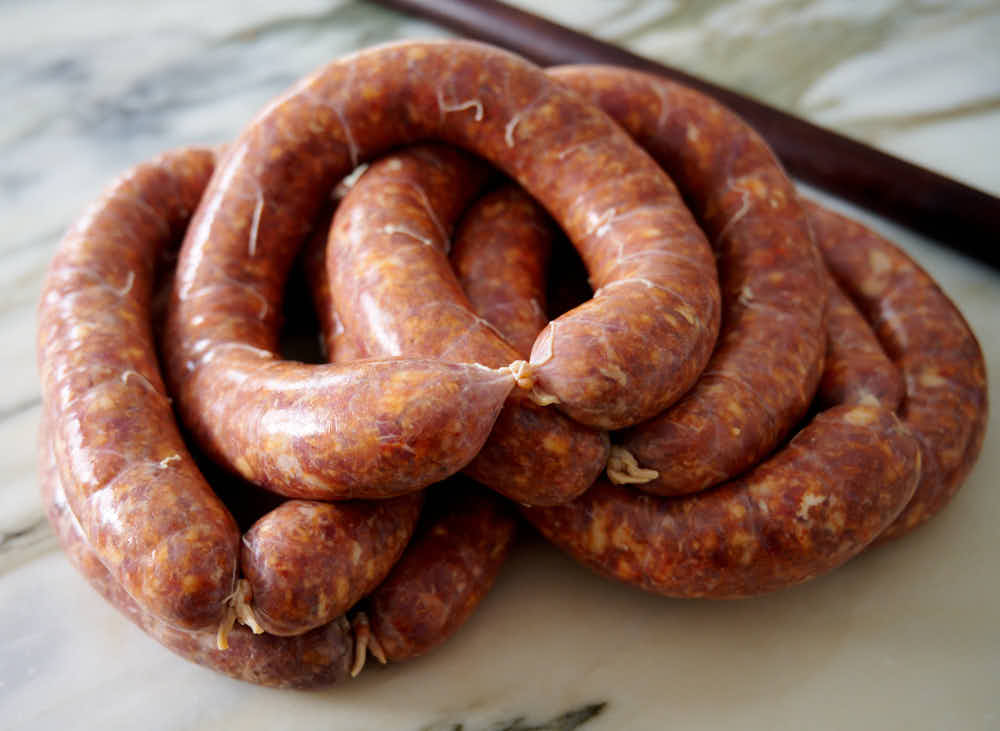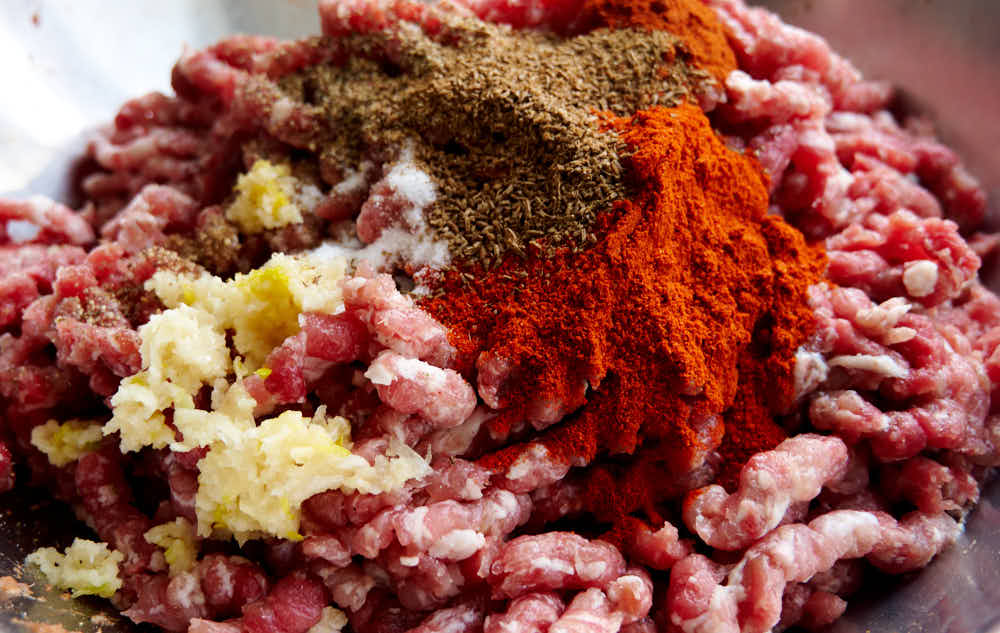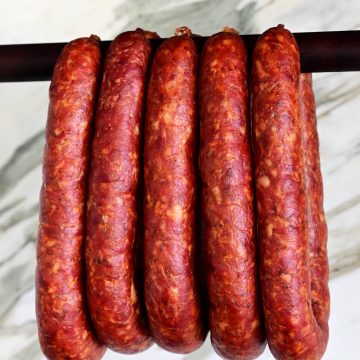I've been on the hunt for a really good, rustic Hungarian sausage called kolbász seasoned with paprika, the peasant kind of sausage that you'd find still made in villages. Storebought Hungarian is just not it. I was able to find several recipes and references to how this sausage is made by locals that put me on the right track, and here it is - a really, really good traditional Hungarian sausage recipe.

How traditional Hungarian sausage is made
Mind you, this recipe is not exactly how they'd typically make kolbász in rural Hungary. There, this sausage would be cold-smoked for at least 12 hours, then hung to dry in a 'cool, airy' place. This type of 'smoked and dried' sausage making would typically take place in cold weather, mostly in winter, to keep the sausages cold at all times to 'prevent spoilage'. I'd say spoilage should be as much of a concern as contamination with harmful bacteria.
Regardless, all this is done without the help of nitrates, nitrites, or bacterial starter cultures. I've made several sausages like that but did it only with heritage pork purchased from a small trusted farm, and I did all the butchering myself with sterilized knives and kept the pork as clean and cold as possible. Was it worth it? Probably not. I like the color and the flavor that sausages acquire when using nitrites/nitrates. I also like the comfort of knowing that with nitrites/nitrates my sausages are 100% safe to eat.
About this recipe
That said, this Hungarian sausage recipe is for a fully cooked, smoked type of sausage, made following the current USDA safety guidelines. I adjusted the level of salt to be in line with my smoked sausage recipes as traditional Hungarian sausage that is cured is saltier.
If you want to make a 'fresh' version of this sausage, substitute Cure #1 with an equal amount of salt.

If you want to make your Hungarian sausage more like the traditional 'smoked and dried' version, substitute Cure #1 with Cure #2, add a starter culture, and add more sugar or dextrose, depending on what starter culture you will be using. You'd also want to bump the salt up to 2.8% - 3.25% for safety.
Spices and seasonings
The spices are true to what you'd find in a traditional Hungarian kolbász - hot and sweet paprika, caraway, and garlic. I've seen recipes with black pepper and without and with and without garlic. I went with what I personally like, so 'yes' to pepper and garlic. Some recipes I found used cumin, but I am not a fan, so I use freshly ground caraway seeds.

Sugar is not a common ingredient in this sausage though I did find a couple of recipes using it. My recipe does, too, as I find that it improves the overall taste of any pork sausage, and it certainly does in this one.
The proportions of hot and sweet paprika vary to suit a butcher's/customer's personal taste, there is no standard here. Typically, you will find hot paprika constituting anywhere from 20% to 30% of the total amount of paprika. Some sausages use only sweet paprika. My personal preference is to use about 18%-20% of hot paprika and 80% of sweet paprika, which gives me a pleasant mild heat. Without it, this sausage tastes boring. More hot paprika begins to turn some people off. So, 18%-20% is a good starting point.
Using fresh, good-quality Hungarian paprika in this sausage is crucial. The fresher it is, the more aromatic it is, and it makes a huge difference to the final taste. I think the color of the sausage is better, too, when using fresh paprika.

Ingredients
- 4 1/2 lbs pork butt
- 1/2 lb back fat or pork belly
- 1 3/4 Tbsp kosher salt
- 1 tsp Cure #1 level
- 2 1/2 tsp black pepper
- 6 1/2 Tbsp sweet paprika
- 3 Tbsp hot paprika
- 7 cloves garlic pressed
- 3 tsp caraway seeds ground
- 1 tsp sugar
- 1 cup ice water
Instructions
- Cut the meat, and the back fat, into 2" (5-6 cm) pieces, mix with salt and Cure #1. Place in a container, cover, and refrigerate for 24 hours.
- Grind the pork and the pork belly/back fat (partially frozen for 20 min in a freezer) through a medium-size plate - 1/4" (6mm). You can also chop the meat and the fat finely with a knife.
- Mix the ground meat with the seasonings, adding a cup of ice water. Mix well until the meat becomes sticky.
- Stuff into hog casings (28-32 mm), making 1-foot lengths and tying them into rings. Prick any visible air pockets with a needle.
- Hang the sausage to condition in a cold room at 33F - 38F (like an unheated garage in winter) or refrigerate overnight. Do not let the sausages freeze.
- Dry for about 60 minutes in the smoker at about 110F - 130F without smoke. The sausages should be completely dry before applying smoke.
- Smoke at around 130F for 2-4 hours or until the casings develop a nice brown color. Use oak, beech, cherry, hickory, or pecan wood.
- Next, poach at 161F - 165F for 25 - 35 minutes or until the internal temperature reaches 154F -158F. Alternatively, bake in an oven with convection, with a hot water pan below the sausages, at 175F for about 30-50 minutes or until the internal temperature reaches 154F - 158F. You can also finish cooking the sausage in the smoker/smokehouse by gradually increasing the temperature in the smoker to 165F-175F-185F and up to 195F. This method is not as easy and may take a long time depending on weather conditions and humidity inside the smoker.
- Cool the sausages down in an ice bath or shower them with cold water and dry them with paper towels. If you have access to a fairly cold room, again, like an unheated garage in winter, just hang them there to cool down.
- Optionally, hang the sausage in a cool room or a curing chamber for 5-7 days to dry at about 55F and 75% relative humidity. This will prolong the shelf life and intensify the flavor of the sausage.
- Store in a refrigerator.


Jeff Culbert says
I've been wanting to try this for a while..i finally got around to it. I used 1 1/2 teaspoons of cayanne. Adding heat to any sausage is risky.. what is hot to one, is not to another..
I'll be making this on a regular basis along with other recipe's you have on your site.
Cheers!
Victor @ Taste of Artisan says
Glad to hear it, Jeff. Enjoy!
Karen Bodnar says
My dad was hungarian, his parents born n raised in Hungary. Came to America in early 1900s.
The recipe we use when making our hungarian sausage was my gramma's. I'll just use a 4# batch.
4# Boston butt, ground up
6-8 cloves of garlic
6 tsp Black pepper
3 tsp Salt
I was taught when spices are added n you check it, b pepper should be well speckled throughout n a very strong smell of garlic.
My family used to get together n make 250-300#.
Victor @ Taste of Artisan says
Thank you for sharing your family recipe, Karen. It's interesting how your family skipped on paprika, which is very common in Hungarian sausage recipes. Then again, I've seen many regional recipes differ from one another quite significantly sometimes. You can have two neighbors making the same sausage and it would taste very differently as each would put his own spin on it, own spices, etc.
John says
First try, perfect.
Excellent recipe and tasty too.
Thanks
Victor @ Taste of Artisan says
You are welcome. Great to hear it. Enjoy!
Jan Jozsa says
We make two traditional Hungarian sausages because my in-laws grew up in rural Hungary and Transylvania. Their sausages (one of which is Kolbasz) are not smoked and they are delicious. Personally I don't like smoked food and react to it but I can eat the unsmoked sausages. We freeze them till we are ready to eat them. The other sausage, made with pork mince, rice, loads of garlic, salt, black pepper and marjoram is called Horka but I cannot remember how to spell it.
That is the best one.
Victor @ Taste of Artisan says
Thank you for your feedback, Jan. Pork sausage with rice - this sounds like something I'd love to try.
We also make a lot of fresh sausage and freeze it; it's great for making quick dinners. Air frying them works best.
Tom Dworek says
I would love to have the Horka recipe . Boy you miss the old guys when their gone
Tomas says
Victor, I love your sausage recipes! Do you usually do these in metric or US? I am finding a slight discrepancy between amounts of paprika... 3.5 tablespoons is closer to 21g than 40g... usually, I am inclined to err on the side of weight. Also, have you ever tried using paprika paste? Certainly not meant as a critique... want to make it right!
Victor @ Taste of Artisan says
Hi Tomas, you are correct, it was a typo and I corrected it. I use metric all the time but try to provide US common measure as well as I get many requests for that. Some people also ask for ingredients for 5 lb batches while others want per 1000g. Typos creep in sometimes. Glad you mentioned it, I want everything to be precise. I also made some very minor tweaks to the rest of ingredients based on the notes from my recent batch.
No, haven't used paprika paste but sounds like a good idea. Enjoy!
Buz says
This is some of the best sausage I've ever made. I used 3 tsp granulated garlic(not powder) instead of fresh, 1 tsp red pepper flakes instead of hot paprika, 3 tsp mustard seed, and added a little white vinegar for 4.7 lbs of pork butt. Smoked for 4 hours on the big green egg then finished off in the oven to get the temp up to 155F. All the flavors like the caraway blend together after cooking for something really good.
Victor @ Taste of Artisan says
Awesome. Glad to hear it. Enjoy!
Alan says
To what extent can liquid smoke be used other than actual smoking the sausage
Bradley says
Beautiful illustrations of your sausages 🙂
I started making my own hungarian sausages as well recently.
After years of searching for an authentic recipe I came upon one similar to yours. Am only on my 3rd batch and so far happy with results. There is no other sausage I am aware of that can compare to good hungarian sausage!
Thanks for sharing all your creations... the internet is such a treasure trove to those not us who seek to know more !!
Victor @ Taste of Artisan says
You are very welcome. I am glad you liked this recipe, it's one of my favorite ones, but I have to say that there are many other sausage recipes that are excellent. Enjoy!
Richard Demeester says
Victor quoting your words....
"If you want to make your Hungarian sausage more like the traditional 'smoked and dried' version, substitute Cure #1 with Cure #2, add a starter culture, and add more sugar or dextrose, depending on what starter culture you will be using. You'd also want to bump the salt up to 2.8% - 3.25% for safety"
Any chance you could post the recipe with these changes in it? I am not sure of how much of the starter culture/dextrose/salt based on your above recipe would be required to make the sausage safe....
Thanks for your time...
Victor @ Taste of Artisan says
Will do, though you could take any of my dry cured sausage recipes and just substitute the meat/seasonings. By the way, I've watched a number of videos of folks making traditional Hungarian, Croatian, etc. sausages, one of them Sremska, one of my favorite sausages, and they just add 2% salt, no curing salt ot starter cultures, and dry in 'cool rooms'. Not something I would do with commercial meat as the risk of contamination is very high.
Brody says
I’ve only recently started making home made sausages. Tried winging it for my first batch (they didn’t turn out very good) Made these for my second. And I am blow away! Some of the best sausages I’ve ever had. Very excited to try out some of your other recipes. *** If you are scrolling through the reviews to check if these are worth making trust me they are!***
Victor @ Taste of Artisan says
Hi Brody, thank you for the kind words. It's funny, what you described as you as your first sausage-making experience is exactly what mine was back when I started. I tried to make fresh Macedonian sausage, a replication of our favorite store-bought sausage back then. I also tried winging it and it came out pretty bad, though I thought I did everything right... LOL. Happy that my blog helps you and my other readers make excellent sausage, bread and other goodies. That's the goal.
Bibi Bong says
More to my taste! Thank you for sharing!
Will says
Made this at the weekend, and cold smoked it across two days (about 10hours total). I decided to go the dry cured route instead, simply because I have had similar salamis visiting friends in nearby Slovakia. These sausages have long been one of my favourites, and the test sample I had was amazing even before smoking and curing. I'm so glad I have found such a great recipe for them. Thanks for posting this!
Victor @ Taste of Artisan says
Good to hear it, Will. Enjoy! I am planning on dry-curing this sausage soon as well.